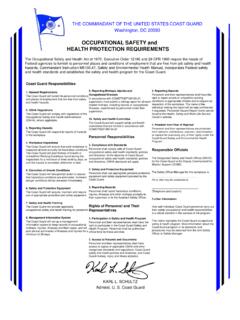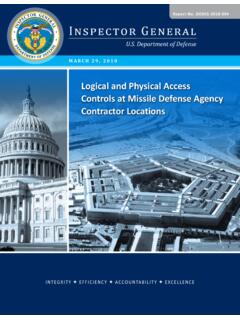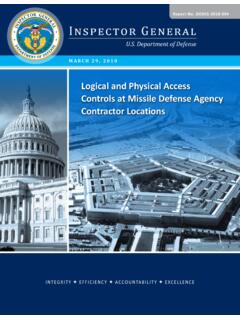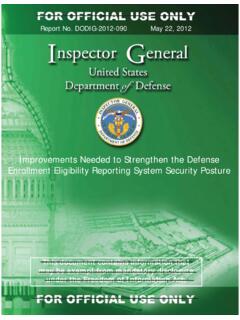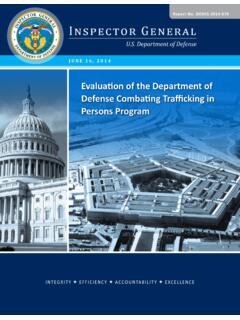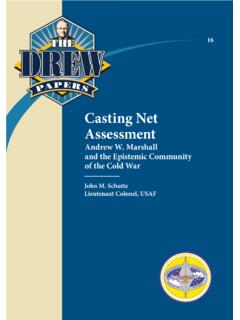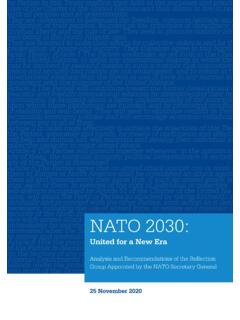Transcription of A DESIGN FOR MAINTAINING MARITIME SUPERIORITY
1 A DESIGN FOR MAINTAININGMARITIME SUPERIORITYV ersion 20181 MISSIONWhy DESIGN What has changed?The United States Navy will be ready to conduct prompt and sustained combat incident to operations at sea. Our Navy will protect America from attack, promote American prosperity, and preserve America s strategic influence. naval operations from the seafloor to space, from the blue water to the littorals, and in the information domain will deter aggression and enable resolution of crises on terms acceptable to the United States and our allies and partners. If deterrence fails, the Navy will conduct decisive combat operations to defeat any DESIGN for MAINTAINING MARITIME SUPERIORITY , Version , released in January 2016 ( DESIGN ), was explicitly intended to be assessed and, if necessary, revised to stay relevant.
2 This update reflects the first reevaluation. There were three reasons we undertook this first reason was to ensure our plans were aligned with updated strategic guidance. President Trump issued a new National Security Strategy (NSS) in December 2017, and Secretary of Defense Mattis issued a supporting National Defense Strategy (NDS) in January 2018. A new National Military Strategy (NMS) will follow. These documents orient national security objectives more firmly toward great power competition. While DESIGN highlighted that competition, these new strategies demand that we reevaluate our current heading to ensure it maximizes the Navy s contribution to the objectives they set second factor driving our assessment was to account for progress that has been made since DESIGN was issued.
3 We have accomplished many of the tasks it articulated, and have advanced many more it s now time to define what comes next. The third motivation was to validate DESIGN s characterization of the strategic environment, to check our reflects the results of this assessment. Overall, the structure of DESIGN provedsound: the characterization of the security environment, the Core Attributes, and the Lines ofEffort (LOEs) remain valid and relevant. Readers should recognize the new version as a continuation of DESIGN ; a major course change was not are, however, some adjustments. DESIGN provides updated operational guidanceto link strategy with execution. The Achieve High Velocity Learning Green LOE hasbeen tightened, focusing on outcomes rather than processes.
4 The tasks supporting all of the LOEs have been updated to establish new and ambitious goals that will spur us to accelerate our progress. This is an all-hands DESIGN , DESIGN establishes the framework to guide our behaviors and investments this year and in the years to come. More specific details about programs and funding adjustments will be reflected in our annual budget EnvironmentThe United States Navy will aggressively compete, harnessing three forces that continue to shape our modern security environment: - The increasing use of the MARITIME domain the oceans, seas, waterways, and seafloor. - The rise of global information systems, especially the role of data in decision making.
5 - The increasing rate of technological creation and adoption. It has been decades since we last competed for sea control, sea lines of communication, access to world markets, and diplomatic partnerships. Much has changed since we last competed. We will adapt to this reality and respond with future of the United States depends on the Navy s ability to rise to this challenge. As discussed in the 2018 NDS, China and Russia are deploying all elements of their national power to achieve their global ambitions. In addition, our competitors have been studying our methods over the past 20 years. In many cases, they are gaining a competitive advantage and exploiting our vulnerabilities. Their activity suggests that Eurasia could once again be dominated by rivals of the United States, our allies, and partners.
6 China and Russia seek to accumulate power at America s expense and may imperil the diplomatic, economic, and military bonds that link the United States to its allies and partners. While rarely rising to the level of conflict, Chinese and Russian actions are frequently confrontational. And these actions are not only directed at the United States: China and Russia seek to redefine the norms of the entire international system on terms more favorable to themselves. 4 This global competition extends to the MARITIME domain, including the seabed, and importantly, to newer domains: space and cyber. The new security environment is shaped by the following facts: - Our competitive advantage has shrunk and in some areas, is gone altogether.
7 We do not have the margins we once enjoyed. - Twenty-first century competition takes place over a wide range of conceptual approaches from peaceful competition to violent conflict. This competition involves all elements of national power. - The competitive space has expanded to new domains, fueled by technological advances as well as the amount and availability of information. - The pace of competition has accelerated in many areas, achieving exponential and disruptive rates of change. As this pace drives yet more unpredictability, the future is becoming increasingly uncertain. Identifying mid- and near-term outcomes will become more challenging.
8 - We cannot become overwhelmed by the blistering pace. This is a long-term competition. We must think in terms of infinite, instead of finite, time frames. Only sustainable approaches will ResponseTo recapture strategic momentum and grow our advantages in the MARITIME domain, the Navy will act with a sense of urgency and creativity. Three central themes will guide our response:1. The Navy will become more Navy will develop concepts and technology to expand the competitive space as the 2018 NDS directs. With the Joint Force, we will restore agility conceptual, geographic, and technological to impose cost on our adversaries across the competition-conflict spectrum.
9 Our efforts will be prioritized to exploit our strengths against our competitors weaknesses. We will leverage the creativity and expertise of the is essential to develop options for the full spectrum of competition. Naval concepts and capability development will appreciate that this spectrum is fluid from peaceful presence to total war. Our competitors see the landscape as continuous; we will do so as well. Restoring agility means realizing that operating in the spectrum can be non-linear and simultaneous our adversaries can operate at different levels of intensity in different domains at the same time. We will not let rigid thinking or self-imposed structures prevent us from operating in creative 1: The Competition-Conflict Spectrum for the Military Dimension of Power.
10 Navy concepts and capabilities should improve our ability to respond to an adversary across the spectrum from day to day operations, to escalation, to lethal The Navy, fighting with the Joint Force and with our allies and partners, will control the high end of MARITIME Navy is a key enabler of the Joint Force s ability to prevent China and Russia fromcontrolling the Eurasian rimland and its adjacent seas. We will protect the sea lines ofcommunication between the United States and its allies and partners. 2. The Navy will compete in ways that are in the short- and long-term the pursuit of ends that are beyond the waysand means of the force is self-defeating. Over the long timelines that characterize thecurrent competition, the Navy will be ready to fire effectively first, but also be able to defend and return fire.

